Achu Soup (Yellow Soup) & Achu
Achu Soup (Yellow Soup) & Achu – gloriously yellow, delicate soup prepared mostly in Cameroonian home cooking and fairly common in the Western and North West province. It is always paired with mashed/pounded achu coco (taro).
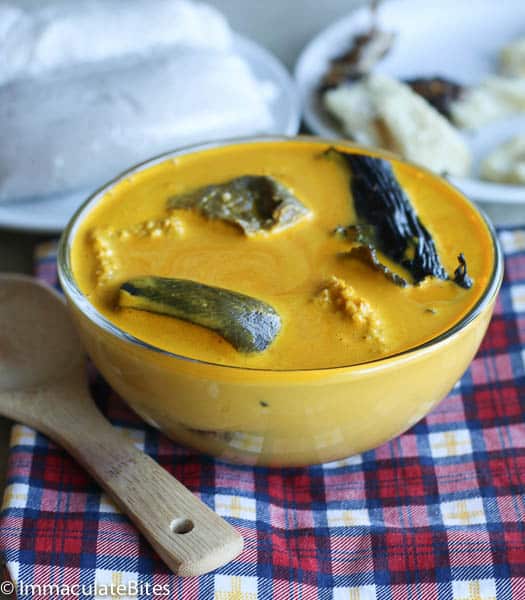
If you have been looking for a recipe for Achu soup also known as (Yellow soup ) sauce jaune – here you go…
This has been on my blog to do list forever, but kept putting it off for one reason or another until now. I am starting the New Year with this one- a hometown favorite!
This gloriously yellow, delicate soup can be superb or catastrophic, depending on whether you carry out certain essential points. Traditionally it is made with a collision and fusion of beef or chicken broth, red oil, limestone and a variation of spices.
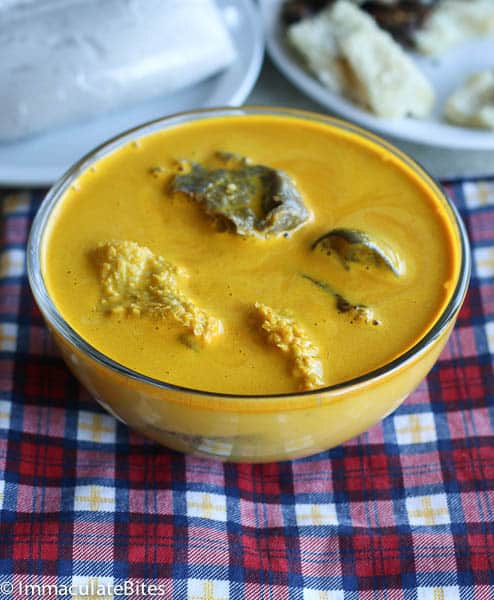
To be honest, most of the spices I really cannot identify by name. They are always grouped together –sold as achu spice. That’s how I buy them.
The modern version of this soup is ridiculously easy to make .The liquid fusion can be accomplished using a blender –giving it an added dimension of smoothness; in less than 2 minutes you are done. How cool is that?
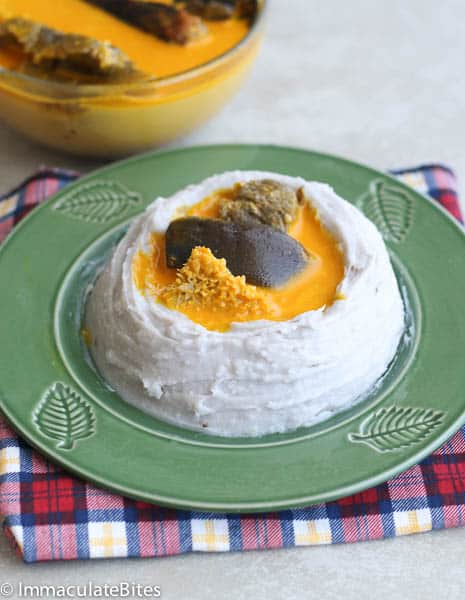
This dish is typical of Cameroonian home cooking, fairly common in the Western and North West province. It is always paired with mashed/pounded achu coco (taro). Here ,I used the food processor to blend the achu coco. If you have a mortar and pestle and desire a smooth consistency and perfect texture, then by all means use it! For mortals like us, this is as good as it gets.
Before you pound away … here is a question for you. Is Ok to eat Achu soup with a spoon? Yes or No?
Watch How to Make It
[adthrive-in-post-video-player video-id=”uw0VjiwK” upload-date=”2021-03-20T07:00:00.000Z” name=”Achu Soup (Yellow Soup) & Achu” description=”Achu Soup (Yellow Soup) & Achu – gloriously yellow, delicate soup prepared mostly in Cameroonian home cooking and fairly common in the Western and North West province. It is always paired with mashed/pounded achu coco (taro).” player-type=”collapse” override-embed=”false”]
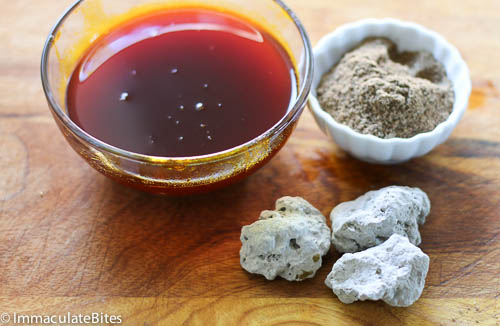
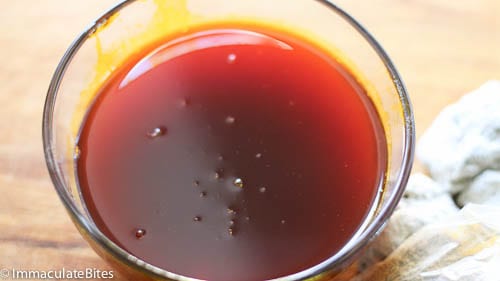
Warm oil to get it into liquid form( you may do so on the stove or in a microwave)
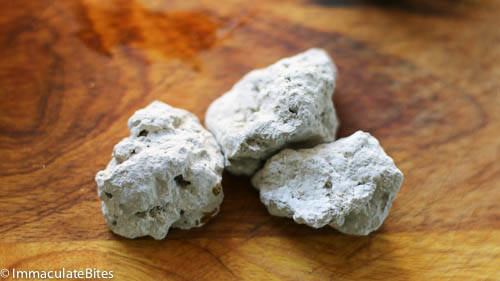
Crush limestone using a rolling pin or just purchase the ground one.
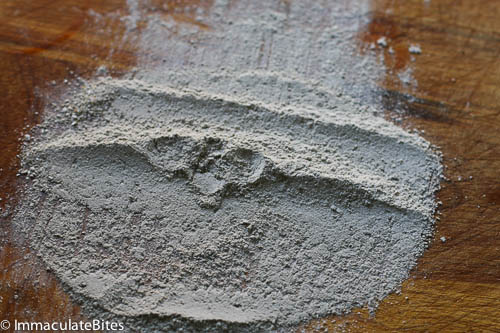
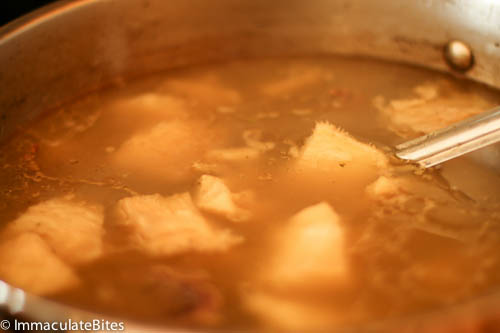
Boil meat until tender ( depends on type of meat used ). For a more flavorful achu soup include smoked fish. Remove meat and reserve broth. Let it cool.

Place broth in the blender together with achu spice, oil, limestone and palm oil
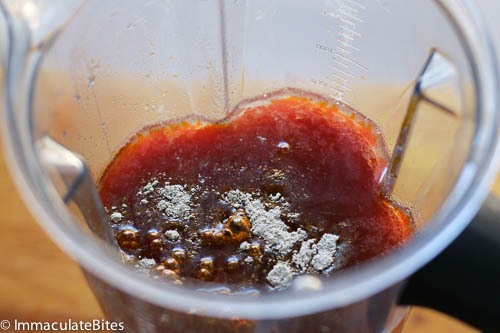
Like this! Pulse several times
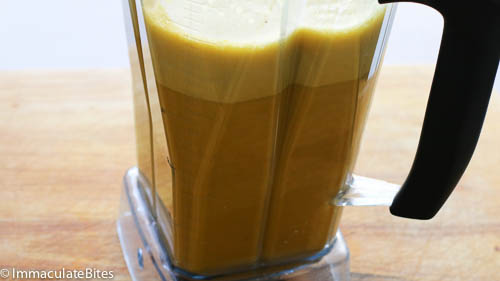
To get this consistency
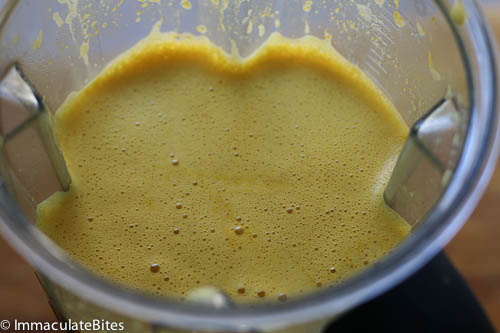
Adjust for salt and maggie

Voila achu soup- you may add the meat at the point or serve with meat on the side.
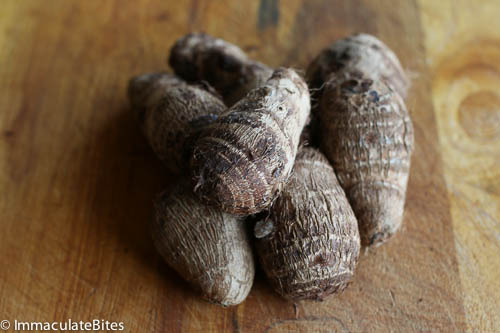
Boil taro until tender( about 45 minutes). Drain water and let it dry out.
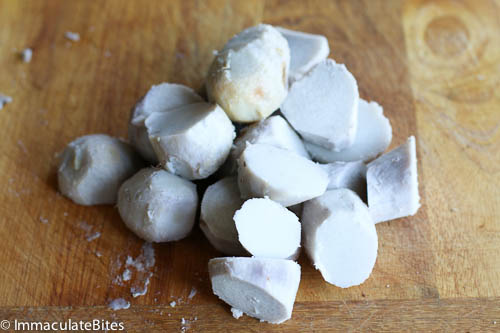
Carefully peel away the skin using a knife(sometimes they come off easily without a knife). Cut in medium pieces
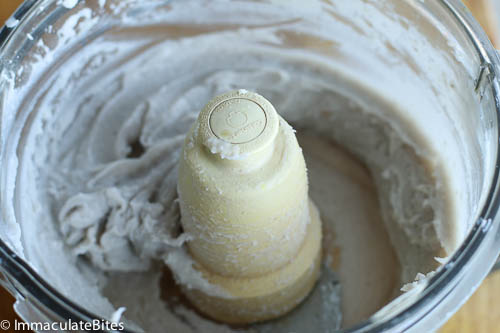
Puree taro( cocoyams ) in a food processor into a fine consistency ( do not use any water)
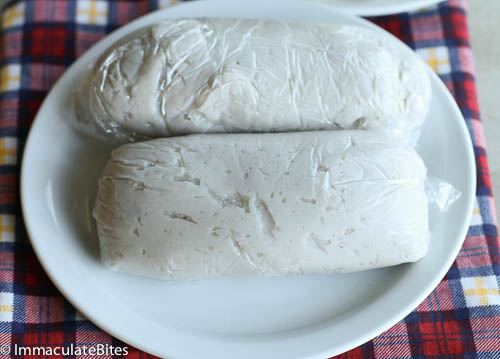
Wrap in plastic paper -serve warm

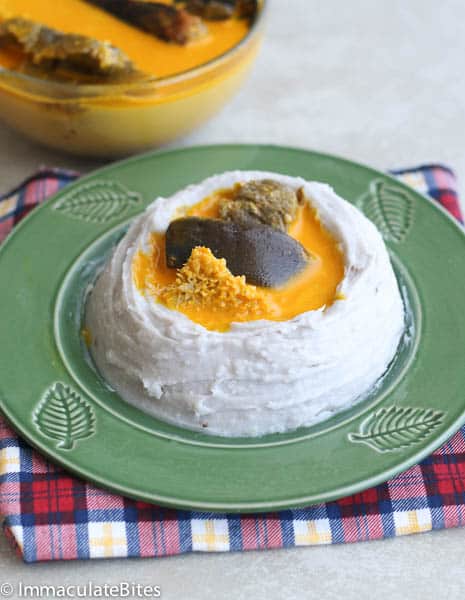

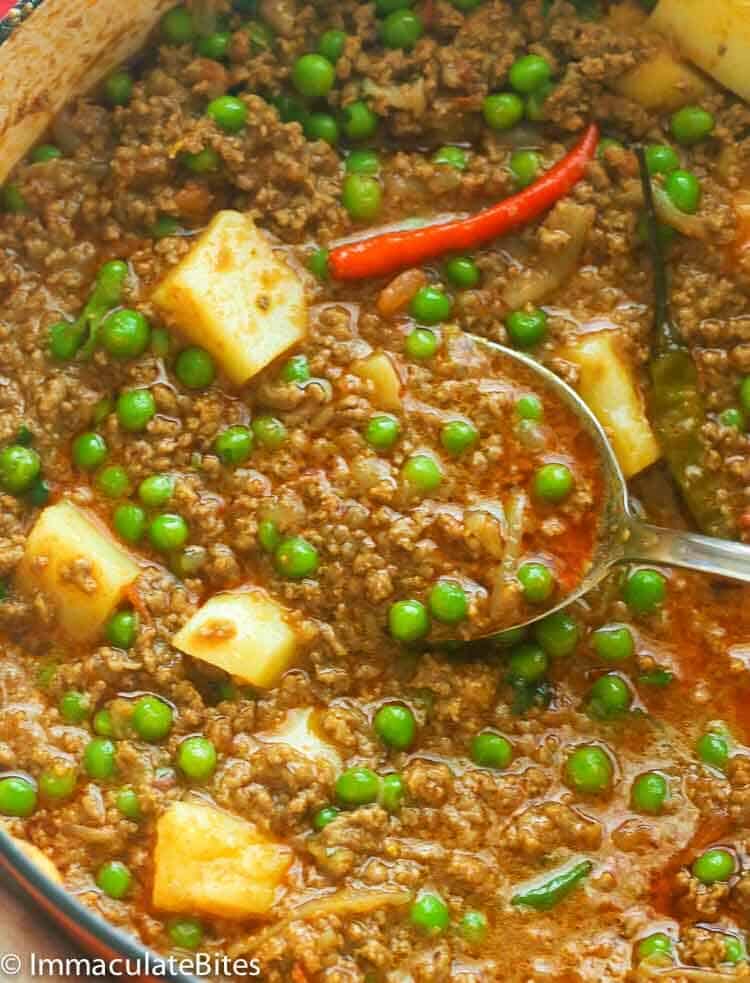


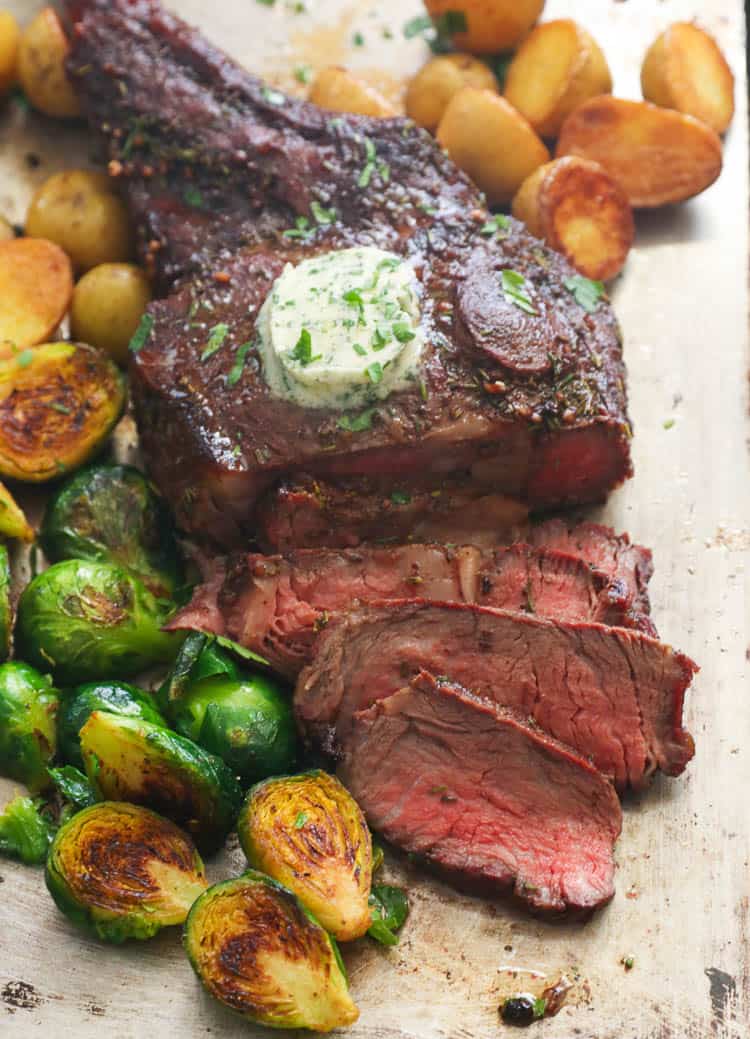

hi Imma thanks for this recipe i will most definitely try it tomorrow thanks
Awesome! Do let me know how it works out for you. Thanks !
Can I use a pot to pound the coco yam ?
If that’s what you have, go for it . Hope it goes well once you try it please share your experience.
Thanks for this. But please I have a worry, what is the role of the local species of bananas added to the cocoayam by some Cameroonians?
It helps to give the coco yams a soft and smooth texture.
What happens if you peel your cocoyams before boiling?
Hi Annick. Peeling the cocoyams might end up with mushy cocoyams. Leaving the peeling on ensures that it is soft but not too wet. Hope this helps :)!
This was of great help. I am in the US and can’t seem to find limestone. Would you have a suggestion of what company packages it or where to find it?
B
Check out this market here . They do carry it http://tropicalfoodinc.com
I need to find limestone. Where can I?
Hi Fannie! Check out this market here . They do carry it http://tropicalfoodinc.com
Thanks, but could you also give us the nutritive value of thus wonderful dish?
Ill do my best to do a nutritional analysis on this.
I love this dish do much but fear sometimes think I can’t make it. With this briefing I now believe I can do it. More grace to you
Can’t wait for you to try this, Mira. Please do let me know how it works for you.
Hello Immaculate!
My wife (western Cameroonian) and me (German) are discussing about the function of the limestone in this soup. Please, could you tell me, what does the limestone do in this dish? What happens, if there is no limestone used?
Yours thankfully
Andreas
Hi Andreas!
I hear you! We’ve have had many discussions centered around this soup and limestone before . Limestone stone helps in emulsifying the broth and oil. You can’t blend water and oil together without some sort of chemical to keep it together.
And that’s the role of limestone. It helps break down the the oil and broth together to form the yellowish color, inherent in achu soup.
Hope this helps.
That’s why at my restaurant I use (Nikki. Plantain peels) rather than limestone.
Hi Imma,
I really do love your recipes! Please do keep the good work and may God bless you. I just have a comment on the limestone use in Achu soup and its diatery importance. Limestone is a very rich source of calcium (needed for healthy bones). Limestone is used to enrich bread and cereals with calcium, livestock feed too just to name a few.
Hi Esther! Thanks for taking the time to share this with us. Very informative.
You can mix the very big taro root and the small one the big one are harder and the smaller one are soft so it will create a better texture soft but not overly soft like when you use the small taro root only . Just my 2 cents thank you again for all you do
What a great tip! Thank you so much for taking the time to chime in. Will definitely give it a try when I make it next time.
Imma,
I think you are giving me hope. Am an offspring of bamenda parents, and boy that was the saturday meal in the house! I just always thought and professed that I could not make achu, but boy there’s hope. Who knew you could put taro in a food processor. I’d settle for the powdered form which I saw my aunts cook. Watch me walk in during the next family get together and introduce something new (HAHAHA) Shhh am not sure I want to share my new found secret yet lol
There’s hope! Achu is quick and easy dish to make. By the time you are done making some of these Cameroonian Delicacies your family is going to FLIP!
No Worries Girl! My Lips are sealed.
Lovely site dear. Well done
Thanks!
Thanks for this great job. Can u list the mark of the preferred food processor machine or the one u are using? Thanks
I use Cusinart- There are various sizes , check it out at amazon and pick the one that works for you. Mine is the Cuisinart FP-14DC Elite Collection 14-Cup Food Processor
Glad it worked out for you Ema.
Thanks very much..I.m from Bamenda but everytime i make my soup the oil always seperate but with the blender it.s perfect thanks again..
Thanks very much for all these. I could not imagine my self using a blender to mix all the ingridents..Very good idea..
Thank you so much Imma, you are a lifesaver 🙂
Happy to be of help!
loved the achu soup. The taste was great. Very easy to make. But most of the Taro was discarded. Next time I will use cocoyam fufu instead. Thanks a lot.
Kelsey ,sorry to hear about the Taro, sometimes they can be tricky depending on the ones you get. Thanks for the feedback!
Hi Imma,
Thanks for sharing.
Before I try out this recipe, kindly educate me on how healthy limestone is to the body
Nina, there is not much to be said about limestone- it is certainly not healthy for the body. To be on the safe side you may use baking soda. I have never tired it but a lot of people I know, have used it and they say it works just fine. Thanks for stopping!
Hi ImmaculateBites,
nice recipe, thanks. Much can be said on ‘kanwa’ though…
The results from one study on ‘kanwa’ used in achu soup showed trona (trisodium hydrogendicarbonate dihydrate i.e. a combination of sodium bicarbonate or baking soda and sodium carbonate) to be the main constituent, NOT calcium carbonate (or limestone). You can read here: http://www.academicjournals.org/article/article1380626835_Ekosse.pdf
Trona is a common food additive – check here: http://www.solvair.us/SiteCollectionDocuments/articles/trona_safety_health.pdf
I managed to cook my first achu soup with your help 🙂 Thanks
Dabro,glad you were able to cook your first achu soup and really appreciate the article.
Chaiiii, DaBro, na only analysis for achu soup so? LOL. You fit make man start think say all di years, man dong di drink na chemicals. Formula dem wey I see for da ya articles dem eh, Pa, lef’am so. Anyway, thanks for sharing, bros.
Imma~
You are a darling. Fullstop!!
Thank you, always.
How awesome are you? I love you for this lol!
Immacule, you truly are amazing, you need to please provide lessons, i would come and also be on Youtube!
It would be nice to watch you actually cook stuff, like Nigella Bites..lol!
Thanks.
Patricia
Perfect I have several Cameroonian friends who have made this for me..and I simply love it. They just never got the chance to teach me. Now I can try making this with with your resipe.. Just a few question
I am from Sierra Leone and most of the ingridents you have called I am sure I know them and think it is known
by a differnt name with us, but just want to be sure, red oil is it the same as palm oil…don’t know if you know what palm oil is..but it look so similar to it in the pictures, if you know is it what I use as your red oil…
And I I eat the soup with something eles like cassava fufu or baked fried ect
plantains..
usually when I eat it in Cameroon household I just go for the soup lol, I don’t like it with what Cameroonens usually eat it with.
Please excuse my grammar
Satta Jah
So excited that you are willing to try this Satta. Red oil is the same as palm oil. Now, eat this soup with whatever starchy accompaniment you like- as long as you enjoy it . Please let me know how it works for you.Thanks
God bless you immaculate. So i can now cook achu? Thanks so much for this recipe. I have few questions; about how long should i heat the oil if it’s already in liquid form? If using crayfish, should i boil it together with the meat, i am worried boiling it together with the meats without blending because it might look odd around the meats. Or do i boil the crsyfish separately, blend then add it to the stock. Regarding the taro. Just wondering if it gets smooth without lumps with the use of a food processor . Thank you!!
Aww, thank you.
Now in regard to your questions.
Heat the oil for about 1 minute , then let it cool.Definitely blend the crayfish – just like you would grind coffee( my aunt would often drain the beef broth after boiling the meat and crayfish- you may do so). Your idea of boiling the crayfish separately, blend and add to the stock is great too!
It is ok, to cook achu without crayfish . Most people do . Smoked fish is good enough. I did not use crayfish in this recipe. Did not feel it is needed here..Plus, I am running out of crayfish.
Ok, I have never been able to achieve the smooth consistency that you get from pounding the taro with a mortar and pestle. You will definitely have some lumps in the taro, but not a lot. Thanks once again.